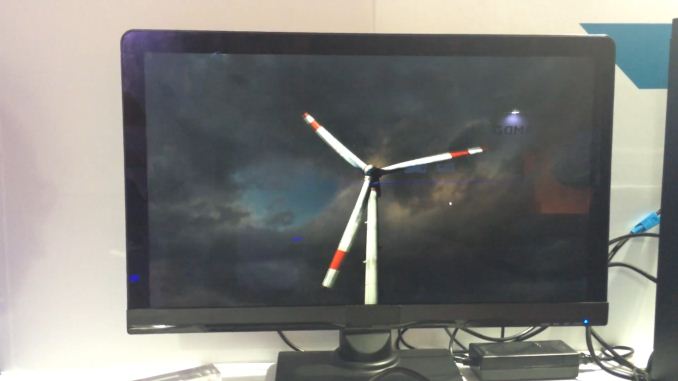Computex 2014: AMD Demonstrates First FreeSync Monitor Prototype
by Ryan Smith & Anand Lal Shimpi on June 5, 2014 6:00 AM EST- Posted in
- Displays
- AMD
- GPUs
- FreeSync
- Computex 2014

Our very own Anand Shimpi just got off of the Computex showfloor for a bit after paying a visit to AMD’s booth. Among the items AMD is showing at Computex is the current status of their FreeSync project, whose base feature of Adaptive Sync was recently added to the DisplayPort 1.2a standard as an extension.
First announced at CES 2014, FreeSync is AMD’s take on variable refresh monitors, utilizing some variable refresh functionality first designed for embedded DisplayPort (eDP). At the time AMD was showing off the concept on laptops (due to the need for eDP) but are back at Computex with an update on the project.
Here at Computex AMD is showing off the first prototype monitor that is FreeSync capable, which interestingly enough is based on a retail monitor that was hardware capable and could be converted with updated firmware. AMD’s actual demo hasn’t changed – they’re still running the fan blade demo we saw at CES 2014 – but it’s now running on external monitors. The monitor in question operates with a fairly narrow range of rates of just 40Hz to 60Hz, which for the purposes of a prototype is good enough to showcase that the technology works, though it is narrower than the refresh ranges AMD is expecting for retail monitors.
At this point AMD is emphasizing that while they were able to get FreeSync up and running on existing hardware, owners shouldn’t be expecting firmware updates as this is very unlikely to happen (though this is ultimately up to monitor manufacturers). Instead AMD is using it to demonstrate that existing panels and scalers already exist that are capable of variable refresh, and that retail monitors should not require significant/expensive technology upgrades. Meanwhile AMD is also holding to their earlier projection of 6-12 months for retail monitor availability with retail prototypes expected around September, which puts final retail availability potentially as early as very late this year, but more likely into the first half of 2015.
Finally we have a video interview of the FreeSync demo in action. It bears mentioning that YouTube is limited to 30fps, so while we can give you some idea of what FreeSync performs like it’s not a fully capable representation. That will have to wait for closer to release when we can sit down with a high speed camera.










44 Comments
View All Comments
Soulwager - Thursday, June 5, 2014 - link
You might get a few seconds before the image disappears completely, choosing the minimum refresh rate is a question of color accuracy and contrast ratio. 30hz was chosen for the VG248QE, but different panels will fade at different rates, so that tradeoff will change based on panel technology and process.SlyNine - Friday, June 6, 2014 - link
110hz and ips... The display maybe trying to refresh at the oced 110hz. But that doesn't mean the panel is keeping up. For now I'm still convinced you need to sacrifice either speed or image quality. Or get a old CRT.invinciblegod - Friday, June 6, 2014 - link
What the, do they exist? I've never seen a 110hz, IPS, 1440p panel!Soulwager - Sunday, June 8, 2014 - link
Some IPS panels have controllers that can be overclocked that high, but it doesn't make the actual panel transition any faster, so the frames tend to blur together. There's a high speed video of it drifting around somewhere.HighTech4US - Thursday, June 5, 2014 - link
Good questions. I hope Anandtech does a side by side comparison of the two technologies.But only G-Sync monitors are available now and F-Sync ones are still out 6 to 12 more months (which makes no sense if it was so easy to do).
tuxRoller - Thursday, June 5, 2014 - link
It's easy because it's part of a spec already. It doesn't require licensing anything. It will be as ubiquitous as dp1.2.The problem on the meantime is that there is lag between the spec and implementation. We're in that valley but it isn't forever and once out everyone gets the benefits of this and not just Nvidia.
SlyNine - Friday, June 6, 2014 - link
The real question is what one offers the least latency. input tests will be interesting.Sabresiberian - Sunday, June 8, 2014 - link
Why do some people assume G-Sync is going to be expensive? There is no reason it should be (beyond monitor manufacturers trying to charge all the proverbial traffic will bear).Soulwager - Monday, June 9, 2014 - link
Performance compared to a high refresh rate fixed refresh monitor, availability of g-sync, availability and potential performance constraints with freesync, cost of development and implementation, and brand value(licensing fees).I expect g-sync prices to stay high until freesync ships, at which point I expect the price to be within 10% of a freesync monitor with equivalent performance.
HighTech4US - Thursday, June 5, 2014 - link
If this is so easy and FREE why does it take 6-12 more months for availability and why can't existing monitors get a firmware upgrade to have it work on them.Seems like something is not free to the monitor manufactures.